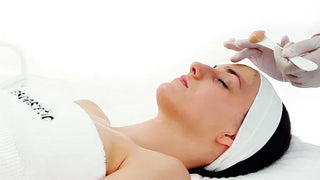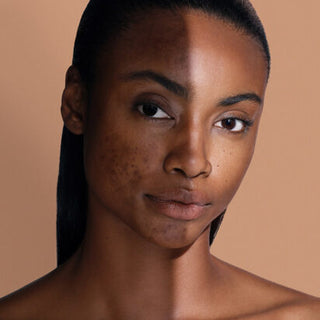Is skin hyperpigmentation life-threatening? Usually not! Can skin hyperpigmentation cause significant psychological discomfort and lower self-esteem? Most often, yes! What exactly is hyperpigmentation, why do unwanted pigment spots appear, and is there a way to effectively get rid of them? Explained by Anita Puļķe, a cosmetologist at the "Health Center 4" branch "Anti-Aging Institute."
The issue of hyperpigmentation is relevant worldwide and affects a very large part of the population to varying degrees. Specialists – including doctors, medical technology manufacturers, and developers of medicinal and cosmetic products – are creating increasingly effective methods to "convince" the skin to cooperate, to get rid of unwanted hyperpigmentation in the long term so that the spots, once removed, do not return at the first sign of sun exposure.
Of course, attention must always be paid to skin formations, moles, pigment spots, and the risk of malignancy should be checked. Therefore, as soon as a previously unseen formation, spot, or change in moles is noticed on the skin, one should visit a dermatologist to be checked. If the doctor confirms that the many pigment spots are just pigment spots, they can be removed using various methods. Read more about it in the article below.
What is hyperpigmentation?
Hyperpigmentation is the result of melanin overproduction, leading to dark spots on the skin. It can occur for various reasons – most commonly due to sun exposure and hormonal changes (during pregnancy or with age), in connection with the use of oral contraceptives, skin inflammations (e.g., acne, dermatitis), injuries, certain photosensitive medications, and the use of household chemicals. Even the aggressive use of inappropriate home care products and decorative cosmetics can cause post-inflammatory hyperpigmentation. It can occur on any skin area, but it is most commonly found on the face, neck, décolleté, hands, and body.
Hyperpigmentation is a complex process involving various skin reactions and histological changes, manifesting as photoaging - structural changes in collagen and elastin fibers (solar elastosis), as well as changes in the skin's protective barrier.
The type of hyperpigmentation known as summer freckles appears in childhood. The number and intensity of summer freckles are related to the phototype or genetics, but - the more time we spend in the sun, the more pronounced the summer freckles become.
With age, spots known as age spots (lentigo senilis) and sunspots (lentigo solaris) can appear. Typically, these are benign formations of pigment cells, most commonly occurring in sun-exposed areas (face, hands, tops of the hands) due to ultraviolet radiation. Excessive sunbathing exacerbates skin hyperpigmentation and causes premature aging.
It should be explained that melanin or the pigment that colors our skin is produced by melanocyte cells. Melanin's task is to protect the skin from burns and tissue damage, including cell DNA damage, by repelling ultraviolet radiation. However, if we are exposed to the sun for too long and too often, melanin is produced uncontrollably and excessively, accumulating the harmful effects of free radicals, leading to changes in the skin. Whether melanocyte activity will be more pronounced largely depends on the skin type and genes – it should be noted that people with lighter skin produce less melanin, so lighter skin burns more in the sun rather than tanning. Sun exposure is the main cause of hyperpigmentation, causing melanin overproduction, but other factors exacerbate this problem.
Hyperpigmentation can also manifest as melasma or chloasma (dark brown to black spots on the face and other body parts). The most common causes are hormonal disturbances, as well as metabolic disorders, less often chemical poisoning. Due to hormonal changes, such pigment spots most often form during pregnancy or after it, as well as in women during menopause. Melasma is the most common hyperpigmentation disorder, which is difficult to treat because the cause is hormonal disturbances, and unfortunately, it may return upon starting treatment.
If increased pigmentation occurs over the entire body, as in cases of melanoderma, the causes can be hormonal disturbances, certain diseases, chemical poisoning, as well as a lack of vitamins or minerals, such as vitamin B12, folic acid, etc.
Hyperpigmentation can also occur after skin inflammations (e.g., acne, pimples, dermatitis), injuries, burns, or insect bites.
Pigmentation changes can have various degrees of severity, ranging from individual spots that differ only slightly from the skin color to very dark spots that cover the entire face, neck, décolleté area.
Hyperpigmentation can be superficial (epidermal) or deeper in the skin layers (dermal), most often it is combined. Of course, dermal hyperpigmentation requires more serious therapy.
Pigmentation disorders are usually associated with intracellular processes (developing within the cell itself) and extracellular (related to surrounding cells), so treatment requires a complex approach.
How is hyperpigmentation treated?
Treatment depends on the cause of hyperpigmentation, its type, and severity. For medical reasons, treatment of hyperpigmentation is usually not necessary, but for aesthetic and psycho-emotional aspects, patients often choose therapy.
Before starting treatment, it is important to consult with a doctor to determine the most suitable method. There are several types of hyperpigmentation treatment. Experience shows that combined methods work most effectively, allowing this problem to be treated comprehensively. Depending on the depth of pigmentation, combined peelings, mesotherapy, lasers, creams, and serums specifically addressing this issue are also used for hyperpigmentation reduction.
When treating hyperpigmentation, it is important to protect the skin from excessive sun exposure, so protective creams with SPF 50 and higher, even SPF 130 during therapy, suitable clothing, sunglasses, and finer details are explained by the specialist performing the treatment.
Hyperpigmentation is usually not easy to treat, therapy can last several months, and often the results do not last long-term or recur. At the same time, it is important to be informed about the most effective ways to prevent hyperpigmentation.
Intensive hyperpigmentation treatment and correction with "Dermamelan®"
Dermamelan® is a patented hyperpigmentation treatment method for reducing melanin overproduction and limiting the formation of new pigment spots in the long term. It is based on scientific and clinical studies in collaboration with leading dermatology clinics and doctors.
The cosmetic manufacturer "Mesoestetic," by compiling and analyzing the most effective concentrations of active substances, has developed an innovative formula based on scientific research, its long experience in this field, and the latest possibilities offered by artificial intelligence in data and information processing. In developing the method, "Mesoestetic" introduced two new patents that allow regulating and correcting the appearance and recurrence of pigmentation.
Dermamelan® is a specific, intensive therapeutic method designed for the most complicated forms of hyperpigmentation treatment and control, and it takes place only under specialist supervision. This procedure serves not only to prevent hyperpigmentation but also to correct it at the cellular level, slowing down the production of melanin itself. Dermamelan® slows down melanin synthesis, inhibits melanin transfer from melanocytes to keratinocytes, reduces the activity of enzymes stimulating melanin synthesis, and decreases inflammation and vascular reactions involved in the development of hyperpigmentation.
Dermamelan® procedure course
The Dermamelan® procedure course lasts four months, during which the client uses home skin care products.
During the first consultation, the specialist performs a thorough collection of anamnesis, skin examination, and preparation for procedures. If there are contraindications, the client is informed and explained all the nuances to be observed during the treatment course.
The client then receives three Dermamelan® products for home skin care to be used for four months:
- A product for hyperpigmentation treatment (contains specific patented active substances, retinol, acids, etc.),
- A medicinal moisturizing product to prevent side effects and complications that may individually occur depending on the skin condition and type (redness, skin flaking, tightness, etc.),
- A product with sun protection factor SPF 130.
The specialist explains how to use the products, in what order, what to consider, and what changes to make during therapy. To answer all questions that arise during the treatment process, the specialist is available for communication with the client throughout the four months.
Dermamelan® - two in one
The Dermamelan® procedure course not only provides effective hyperpigmentation treatment but also has an intense anti-aging effect. It significantly improves skin quality and condition – the skin becomes smooth, radiant, and toned.
Effectiveness of combined procedures
Dermamelan® procedures are also recommended to be combined with laser therapy for reducing hyperpigmentation. It is one of the most popular procedures worldwide and, taking into account each client's individual skin properties (sensitivity, skin structure, phototype, etc.), is successfully applied by specialists at the "Health Center 4".
Dermamelan® procedure four-month course price: 800-850 EUR
Learn also about Cosmelan® procedures, which have a different concentration of active ingredients (the course takes six months) >>
Hyperpigmentation in brief
- What is it? Hyperpigmentation is the result of melanin overproduction, leading to dark spots on the skin.
- Causes. Sun ultraviolet radiation exposure, genetics, aging, hormonal changes, various diseases, burns, injuries, medications, chemical substances.
- When to see a specialist? If changes, new spots, irregular shapes, uneven color formations, etc., are noticed on the skin, to check and determine if there is a risk of malignancy.
- Diagnosis. Anamnesis (patient's medical history), family anamnesis, skin examination, optical and digital dermatoscopy, if necessary – tissue biopsy – invasive removal of a skin sample for analysis.
- Treatment. For medical reasons, treatment of hyperpigmentation is usually not necessary, but for aesthetic considerations, patients often choose therapy. There are several ways to reduce or eliminate hyperpigmentation. To get help, one should visit a dermatologist or cosmetologist specializing in hyperpigmentation treatment. Various procedures are used for treatment, such as medicinal depigmenting (whitening) local methods, chemical peels, laser therapy, skin whitening creams, etc. Before starting treatment, it is important to consult with a doctor to determine the most suitable method, as it depends on the cause and severity of hyperpigmentation.
- Prevention. Use sun protection products, choose clothing, headwear, sunglasses that help reduce the impact of sun ultraviolet radiation, perform preventive checks with a dermatologist, follow doctors' recommendations regarding the use of certain medications and sun exposure.
Consulted by Anita Puļķe, a cosmetologist at the "Health Center 4" branch "Anti-Aging Institute."





